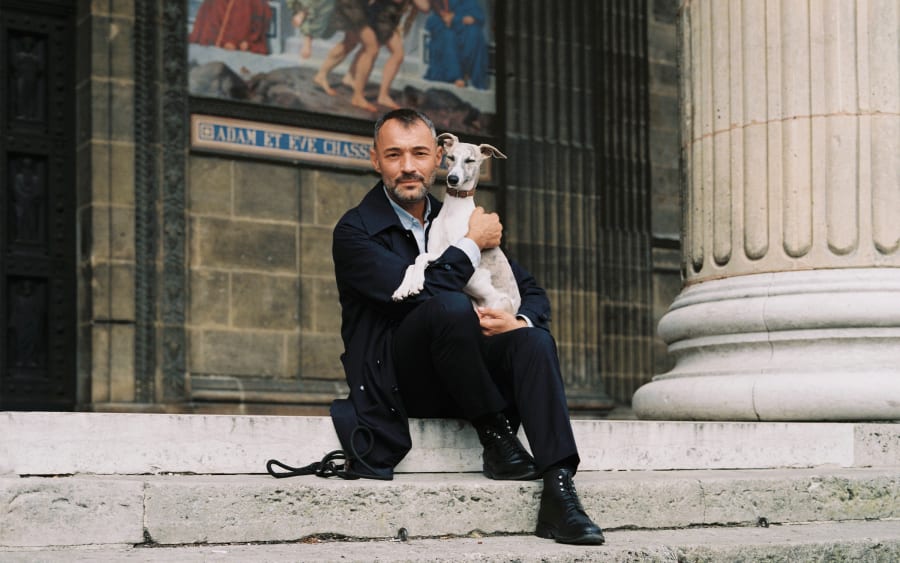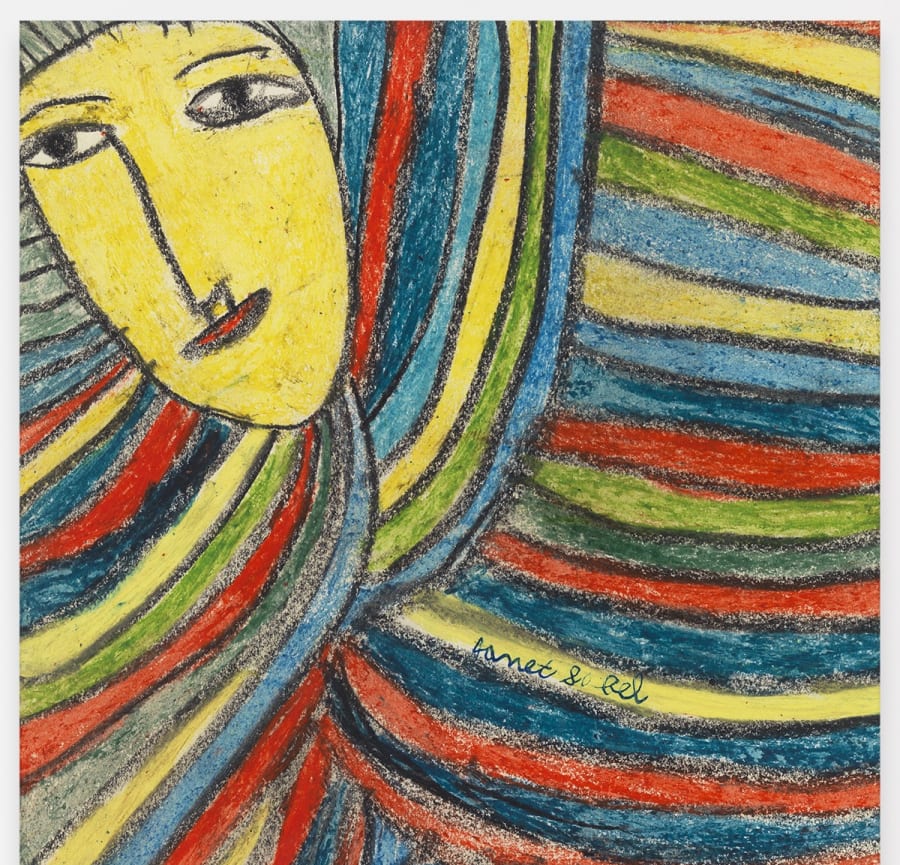With a silk scarf tied around his neck and bits of colored paper from the previous day’s Louis Vuitton catwalk show still stuck to his shoes, Kamel Mennour sits at the large wooden table in his gallery on rue Saint-André-des-Arts. He’s always chic but is adamant that he doesn’t like social events. Born in Constantine, Algeria, in 1965 to a cleaning lady mother and painter and decorator father, he arrived in France at the age of two. Today, Mennour proudly tells me he is the father of five children and has been on the arm of the same woman for over 30 years. This comment comes with a mischievous wink, nodding as it does to the owner (he doesn’t name him) of another established gallery in the neighborhood, with whom he has often been compared. But beyond this little joke, one can sense Mennour’s satisfaction at having been able to carve out a place for himself in a world where the tricks of the trade are often closely guarded secrets, handed down between the well-to-do.
Kamel became familiar with the art ecosystem in the late 1980s through reading and selling lithographs door to door while studying economics at the University of Paris 1 Panthéon-Sorbonne. In 1999, he opened a small space on rue Mazarine, which he dedicated to photographers who were not well known in France at that time, such as Larry Clark and Nobuyoshi Araki. His desire to connect with different art forms led him to broaden his approach. ‘I wanted to look at the world through artists,’ Mennour recalls. In 2003, he started diversifying into the visual arts, but for him, everything really changed in 2007, when the gallery moved to 47 rue Saint-André-des-Arts. Once there, he offered the first show to Daniel Buren, who was soon followed by Tadashi Kawamata (2008) and then François Morellet (2009). ‘I wanted to challenge myself by showing artists with established careers, proven by time. When you’re dealing with sacred monsters, there’s no room for error,’ the gallery owner says. But while cultivating his relationships with the masters of the day, he was also sharpening his focus on the talents of tomorrow. Camille Henrot, who joined the gallery’s roster in 2009, was nominated for the Prix Marcel Duchamp in 2010. Mohamed Bourouissa arrived in 2010 and was nominated for the same prize eight years later. Hicham Berrada joined the gallery in 2015 and was nominated for the Prix Marcel Duchamp in 2020.
In 2010, Mennour was made a Chevalier de l’Ordre des Arts et des Lettres. Then, in September 2013, he inaugurated a new space at 6 rue du Pont de Lodi with works by Pier Paolo Calzolari – a pioneer of the Italian avant-garde movement Arte Povera – before swallowing up the adjacent space. Two years later, the gallery’s fourth space opened at 28 avenue Matignon, in the heart of chic Paris. During this decade, renowned artists, including Lee Ufan (2013), Philippe Parreno (2016), and Ugo Rondinone (2017), were flocking to Mennour’s door, swelling the ranks.
This slow but inexorable ascent was no accident. ‘To keep your artists, you must dare to look beyond your glass ceiling… And our motto is “artist’s first”,’ Mennour says. Aware that emerging figures are more likely to join establishments that are capable of shouldering large production costs, he made sure to maximize the added value of his gallery. ‘Artists are always saying, “What’s next?”, so we ask ourselves the same question.’ In concrete terms this meant that, rather than opening spaces abroad to establish an international presence, as seen with Perrotin, Hauser & Wirth, Pace, and Gagosian, Mennour relied on art fairs to reach new audiences, taking part in every edition of Art Basel (Basel, Miami, Hong Kong, and Paris), as well as TEFAF Maastricht, which he still does. He did once make an exception to his rule, however: On the eve of the Brexit referendum in 2016, he opened a gallery in a space adjacent to Claridge’s in London and rented an apartment in nearby Grosvenor Square, which he only visited three or four times in the end. But: “A gallery is an incarnation… And when Covid came along, I had to face the facts. It was an empty shell, it couldn’t work,” he admits. And so it was time to return home.
To gain visibility beyond his galleries’ walls, Mennour also relies on institutions. He collaborated on Monumenta, the exhibition held in the nave of Paris’s Grand Palais between 2007 and 2016, organized by the French Ministry of Culture and Communication. For this, he arranged gargantuan installations by Anish Kapoor (2011), Daniel Buren (2012), and Huang Yong Ping (2016). He was also involved in the production of Sigalit Landau’s work for the Israeli pavilion at the 2011 Venice Biennale, as well as that of Zineb Sedira for the French pavilion in 2022. Indeed, Mennour admits that plunging headlong into numerous large-scale projects is essential not just to the development of his artists, but also his gallery, pointing to the large-scale projects produced for the Unlimited sector at Art Basel in Switzerland as inspiration. A case in point was the dreamlike collaboration between François Morellet and Tadashi Kawamata for the 2023 edition, while earlier this year, Alicja Kwade presented her imposing work ParaPosition.
In recent years, the collaborative model has extended to the luxury-hotel sector, which is brimming with potential customers and buyers. Mennour has sold a Daniel Buren pergola and a Lee Ufan pavilion to Château La Coste, a wine estate in the south of France that already has an art collection worthy of a museum. In Paris, François Morellet’s L’esprit d’ escalier, which was installed above the Louvre’s Lefuel staircase in 2010, found a new home at Hôtel Costes in 2019.
Unburdened by the weight of the art world traditions he only learned about late in life, Mennour draws strength from thinking outside the box, a way of working that extends to the very structure of his business. In 2022, the appointment of Sylvie Patry, the former director of conservation and collections at the Musée d’Orsay and specialist in 19th-century art, as the gallery’s artistic director came like a bolt from the blue in a world more accustomed to the business dealings of the art market than the confluence of academic minds. Patry joined Christian Alandete, the former head of exhibitions at the Institut Giacometti, who had become the gallery’s scientific director a few months earlier. According to Mennour, these renowned figures from the world of institutions bring a fresh perspective to the sometimes-improvised methods of the commercial milieu. Two years ago, Alandete curated a three-site thematic exhibition devoted to Eugène Carrière, a late-19th-century artist who had fallen into obscurity.
Unerringly insatiable, Mennour continues to recruit for his empire: Last year, the artists Ryan Gander, Claire Fontaine, and Idris Khan also came on board. And after our interview, Mennour was returning to his teams to discuss Sidival Fila, a Brazil-born priest living in Rome. Having met him at the beginning of this year, Mennour announced his representation in June, with a view to offering him an exhibition at the gallery this fall. What’s next?
Maïa Morgensztern is an art and culture journalist and radio presenter based in London. She studied art history at the Sorbonne, Paris, and at the Smithsonian Institution, Washington DC
All portraits of Kamel Mennour by Solène Gün for Art Basel.


